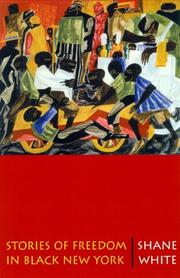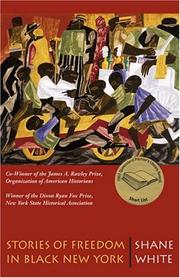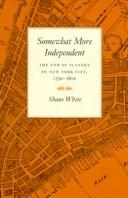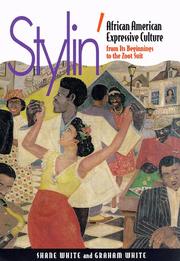| Listing 1 - 7 of 7 |
Sort by
|

ISBN: 0674008936 Year: 2002 Publisher: Cambridge (Mass.) Harvard university press
Abstract | Keywords | Export | Availability | Bookmark
 Loading...
Loading...Choose an application
- Reference Manager
- EndNote
- RefWorks (Direct export to RefWorks)
African American actors --- African Americans --- African American theater --- Slavery --- Abolition of slavery --- Antislavery --- Enslavement --- Mui tsai --- Ownership of slaves --- Servitude --- Slave keeping --- Slave system --- Slaveholding --- Thralldom --- Crimes against humanity --- Serfdom --- Slaveholders --- Slaves --- Afro-American theater --- Theater, African American --- Theater --- Afro-Americans --- Black Americans --- Colored people (United States) --- Negroes --- Africans --- Ethnology --- Blacks --- Actors, African American --- Afro-American actors --- Negro actors --- Actors --- African American entertainers --- Intellectual life --- History --- Social conditions --- Social aspects --- African Company (New York) --- History. --- New York (N.Y.) --- Race relations. --- Social change --- Sociology of minorities --- Theatrical science --- History of civilization --- anno 1800-1899 --- New York State --- Black people --- Enslaved persons --- New York [state]

ISBN: 0674045149 9780674045149 0674025784 9780674025783 0674008936 9780674008939 Year: 2022 Publisher: Cambridge, MA
Abstract | Keywords | Export | Availability | Bookmark
 Loading...
Loading...Choose an application
- Reference Manager
- EndNote
- RefWorks (Direct export to RefWorks)
White recreates the experience of black New Yorkers as they moved from slavery to freedom. Through research, he imaginatively recovers the raucous world of the street, the elegance of the city's African American balls and the grubbiness of the Police Office.
African Americans --- African American theater --- African American actors --- Slavery --- Abolition of slavery --- Antislavery --- Enslavement --- Mui tsai --- Ownership of slaves --- Servitude --- Slave keeping --- Slave system --- Slaveholding --- Thralldom --- Crimes against humanity --- Serfdom --- Slaveholders --- Slaves --- Actors, African American --- Afro-American actors --- Negro actors --- Actors --- African American entertainers --- Afro-American theater --- Theater, African American --- Theater --- Afro-Americans --- Black Americans --- Colored people (United States) --- Negroes --- Africans --- Ethnology --- Blacks --- History --- Intellectual life --- Social conditions --- Social aspects --- African Company (New York, N.Y.) --- African Company of New York --- History. --- New York (N.Y.) --- Race relations. --- Black people --- Enslaved persons
Book
ISBN: 0674056965 9780674056961 9780674051072 0674051076 Year: 2010 Publisher: Cambridge, Mass. Harvard University Press
Abstract | Keywords | Export | Availability | Bookmark
 Loading...
Loading...Choose an application
- Reference Manager
- EndNote
- RefWorks (Direct export to RefWorks)
The phrase "Harlem in the 1920's" evokes images of the Harlem Renaissance, or of Marcus Garvey and soapbox orators haranguing crowds about politics and race. Yet the most ubiquitous feature of Harlem life between the world wars was the game of "numbers." Thousands of wagers, usually of a dime or less, would be placed on a daily number derived from U.S. bank statistics. The rewards of "hitting the number," a 600-to-1 payoff, tempted the ordinary men and women of the Black Metropolis with the chimera of the good life. Playing the Numbers tells the story of this illegal form of gambling and the central role it played in the lives of African Americans who flooded into Harlem in the wake of World War I. For a dozen years the "numbers game" was one of America's rare black-owned businesses, turning over tens of millions of dollars every year. The most successful "bankers" were known as Black Kings and Queens, and they lived royally. Yet the very success of "bankers" like Stephanie St. Clair and Casper Holstein attracted Dutch Schultz, Lucky Luciano, and organized crime to the game. By the late 1930's, most of the profits were being siphoned out of Harlem. Playing the Numbers reveals a unique dimension of African American culture that made not only Harlem but New York City itself the vibrant and energizing metropolis it was. An interactive website allows readers to locate actors and events on Harlem's streets.
African Americans --- City and town life --- Gambling --- Informal sector (Economics) --- Lotteries --- Hidden economy --- Parallel economy --- Second economy --- Shadow economy --- Subterranean economy --- Underground economy --- Artisans --- Economics --- Small business --- Betting --- Chance, Games of --- Games of chance --- Gaming (Gambling) --- Games --- Casinos --- Wagers --- City life --- Town life --- Urban life --- Sociology, Urban --- Afro-Americans --- Black Americans --- Colored people (United States) --- Negroes --- Africans --- Ethnology --- Blacks --- Social conditions --- History --- Harlem (New York, N.Y.) --- New York (N.Y.) --- Harlem, New York (City) --- New York (City) --- Ni︠u︡ Ĭork (N.Y.) --- Novi Jork (N.Y.) --- Nova Iorque (N.Y.) --- Nyu-Yorḳ (N.Y.) --- Nueva York (N.Y.) --- Nu Yorḳ (N.Y.) --- Nyuyok (N.Y.) --- Nuyorḳ (N.Y.) --- New York City (N.Y.) --- Niyū Yūrk (N.Y.) --- Niyūyūrk (N.Y.) --- Niu-yüeh (N.Y.) --- Nowy Jork (N.Y.) --- City of New York (N.Y.) --- New York Stad (N.Y.) --- نيويورك (N.Y.) --- Táva Nueva York (N.Y.) --- Nyu-York Şähäri (N.Y.) --- Нью-Йорк (N.Y.) --- Горад Нью-Ёрк (N.Y.) --- Horad Nʹi︠u︡-I︠O︡rk (N.Y.) --- Нью-Ёрк (N.Y.) --- Ню Йорк (N.Y.) --- Nova York (N.Y.) --- Çĕнĕ Йорк (N.Y.) --- Śĕnĕ Ĭork (N.Y.) --- Dakbayan sa New York (N.Y.) --- Dinas Efrog Newydd (N.Y.) --- Efrog Newydd (N.Y.) --- Nei Yarrick Schtadt (N.Y.) --- Nei Yarrick (N.Y.) --- Νέα Υόρκη (N.Y.) --- Nea Yorkē (N.Y.) --- Ciudad de Nueva York (N.Y.) --- Novjorko (N.Y.) --- Nouvelle York (N.Y.) --- Nua-Eabhrac (N.Y.) --- Cathair Nua-Eabhrac (N.Y.) --- Caayr York Noa (N.Y.) --- York Noa (N.Y.) --- Eabhraig Nuadh (N.Y.) --- Baile Eabhraig Nuadh (N.Y.) --- Нью Йорк балhсн (N.Y.) --- Nʹi︠u︡ Ĭork balḣsn (N.Y.) --- Шин Йорк (N.Y.) --- Shin Ĭork (N.Y.) --- 뉴욕 (N.Y.) --- Lungsod ng New York (N.Y.) --- Tchiaq York Iniqpak (N.Y.) --- Tchiaq York (N.Y.) --- New York-borg (N.Y.) --- Nuova York (N.Y.) --- ניו יורק (N.Y.) --- New York Lakanbalen (N.Y.) --- Lakanabalen ning New York (N.Y.) --- Evrek Nowydh (N.Y.) --- Nouyòk (N.Y.) --- Bajarê New Yorkê (N.Y.) --- New Yorkê (N.Y.) --- Mueva York (N.Y.) --- Sivdad de Mueva York (N.Y.) --- סיבֿדאד די מואיבֿה יורק (N.Y.) --- Sivdad de Muevah Yorḳ (N.Y.) --- מואיבֿה יורק (N.Y.) --- Muevah Yorḳ (N.Y.) --- Novum Eboracum (N.Y.) --- Neo-Eboracum (N.Y.) --- Civitas Novi Eboraci (N.Y.) --- Ņujorka (N.Y.) --- Niujorkas (N.Y.) --- Niujorko miestas (N.Y.) --- Niuiork (N.Y.) --- Њујорк (N.Y.) --- Njujork (N.Y.) --- Bandar Raya New York (N.Y.) --- Bandaraya New York (N.Y.) --- Nuoba Iorque (N.Y.) --- Нью-Йорк хот (N.Y.) --- Nʹi︠u︡-Ĭork khot (N.Y.) --- Āltepētl Yancuīc York (N.Y.) --- Niej-York (N.Y.) --- ニューヨーク (N.Y.) --- Nyū Yōku (N.Y.) --- ニューヨーク市 (N.Y.) --- Nyū Yōku-shi (N.Y.) --- NYC (N.Y.) --- N.Y.C. (N.Y.) --- Economic conditions --- Black people

ISBN: 1280491671 9786613586902 0820343625 9780820343624 0820312452 9780820312453 0820317861 9780820317861 Year: 1991 Publisher: Athens University of Georgia Press
Abstract | Keywords | Export | Availability | Bookmark
 Loading...
Loading...Choose an application
- Reference Manager
- EndNote
- RefWorks (Direct export to RefWorks)
African Americans --- Slavery --- Afro-Americans --- Black Americans --- Colored people (United States) --- Negroes --- Africans --- Ethnology --- Blacks --- Abolition of slavery --- Antislavery --- Enslavement --- Mui tsai --- Ownership of slaves --- Servitude --- Slave keeping --- Slave system --- Slaveholding --- Thralldom --- Crimes against humanity --- Serfdom --- Slaveholders --- Slaves --- History. --- New York (N.Y.) --- Race relations. --- History --- New York (State) --- 1775-1865 --- Race relations --- Black people --- Enslaved persons
Book
Abstract | Keywords | Export | Availability | Bookmark
 Loading...
Loading...Choose an application
- Reference Manager
- EndNote
- RefWorks (Direct export to RefWorks)

ISBN: 0801431794 1501718088 9781501718083 Year: 1999 Publisher: London : Baltimore, Md. : Cornell University Press, Project MUSE,
Abstract | Keywords | Export | Availability | Bookmark
 Loading...
Loading...Choose an application
- Reference Manager
- EndNote
- RefWorks (Direct export to RefWorks)
For over two centuries, in the North as well as the South, both within their own community and in the public arena, African Americans have presented their bodies in culturally distinctive ways. Shane White and Graham White consider the deeper significance of the ways in which African Americans have dressed, walked, danced, arranged their hair, and communicated in silent gestures. They ask what elaborate hair styles, bright colors, bandanas, long watch chains, and zoot suits, for example, have really meant, and discuss style itself as an expression of deep-seated cultural imperatives. Their wide-ranging exploration of black style from its African origins to the 1940s reveals a culture that differed from that of the dominant racial group in ways that were often subtle and elusive. A wealth of black-and-white illustrations show the range of African American experience in America, emanating from all parts of the country, from cities and farms, from slave plantations, and Chicago beauty contests. White and White argue that the politics of black style is, in fact, the politics of metaphor, always ambiguous because it is always indirect. To tease out these ambiguities, they examine extensive sources, including advertisements for runaway slaves, interviews recorded with surviving ex-slaves in the 1930s, autobiographies, travelers' accounts, photographs, paintings, prints, newspapers, and images drawn from popular culture, such as the stereotypes of Jim Crow and Zip Coon.
African Americans --- Social life and customs --- Hairstyles --- United States --- History --- Body image --- Clothing and dress --- Obraz ciała --- Fryzury --- Czarni Amerykanie --- aspekt społeczny --- historia. --- strój --- obyczaje i zwyczaje.
Book
ISBN: 9780674051072 Year: 2010 Publisher: Cambridge, Mass. Harvard University Press
Abstract | Keywords | Export | Availability | Bookmark
 Loading...
Loading...Choose an application
- Reference Manager
- EndNote
- RefWorks (Direct export to RefWorks)
History of North America --- History of civilization --- anno 1920-1929 --- anno 1930-1939 --- New York City --- New York City [New York]
| Listing 1 - 7 of 7 |
Sort by
|

 Search
Search Feedback
Feedback About UniCat
About UniCat  Help
Help News
News